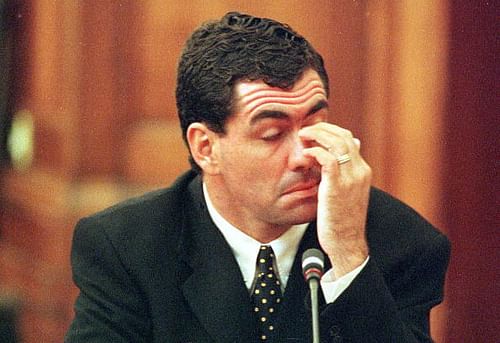
Moments that changed cricket forever: Match-fixing scandals

Hansie Cronje during his cross-examination at the King Commission of Inquiry into allegations of cricket match-fixing in 2000
There are many famous sports, more famous than cricket, involving huge number of fans and money that would bedazzle a common man. And yet cricket, with all its glitz and glamour, is considered to be the sport played by gentlemen. This was at first the literal truth due to the fact that only the nobles were able to afford the game, while the lesser beings toiled for a daily living.
Having said that, the game has definitely evolved with the passage of time. The level of the game is becoming increasingly competitive and the obscene amount of money involved has only increased the worth of the brand, if not anything else.
There are negatives attached to all the positive things in the world – some might say that lends the necessary balance. But match-fixing is something else altogether.
The shadow of match-fixing has latched itself to the game, creeping slowly through the tender minds of youngsters, luring them towards the unbelievable, yet petty luxuries of life. The virus of match-fixing has taken its roots all over the game even as authorities are trying to find a suitable remedy to cure the disease.
What is match-fixing?
The theory of fixing a match is quite simple. There are a network of people who place bets on the outcome of a match, and in order to win the bet they try and acquire the services of certain players who are willing to throw the match away for money, usually through a middle man known as a bookie. The ‘fixed’ player or players deliberately lose the match, thereby cheating millions of fans who have paid to watch their team in action.
The advent of spot-fixing:
Having been busted on so many occasions for trying to fix matches, the bookies then came up with a smart way of earning quick bucks through a relatively easier method called ‘spot-fixing’. In this category, the fixed player has to simply underperform at the stipulated time, thereby helping the bookmakers to earn millions of money. This could go undetected, for its sheer sensibility in its modus operandi. Nobody would suspect an awry over, or an easy wicket.
The Australian dominance seeks trouble: (Year: 1995)
In 1995, two of Australia’s renowned players were marred by match-fixing allegations, of passing on information about pitch conditions to an Indian bookmaker. Though they later reported the incident to their board, they were put on stand and slammed with hefty fines. This would only be a minor incident in Australia’s cricketing books, but the board was quick to declare their intolerance against such practices in the future.
The South African shock: (Year: 1999-00)
The earliest incident of match-fixing, one that shook the bases of cricket, involved a handful of South African players led by their skipper Hansie Cronje. He, along with a few team members, was involved in the scandal that included a few Indian stars as well. It was a well-publicized affair at that time, one that threatened to tarnish the reputation of the game itself. They were invariably caught in the process, having had to forsake their career and reputation.
Other players were scrutinized and an anti-corruption unit was set up by the governing council to prevent outside parties from having access to the players. The board was severely criticized for its negligence and lack of organization.
The Indian allegations: (Year 1999)
The involvement of a few Indian players in the betting scandals were just beginning to surface when Manoj Prabhakar, an ex-Indian fast bowler, claimed to have evidence of match-fixing against the legendary Indian all-rounder Kapil Dev. The allegations went unproven and in a twist of events, Prabhakar himself was caught for his involvement in fixing matches and was banned from playing for India.